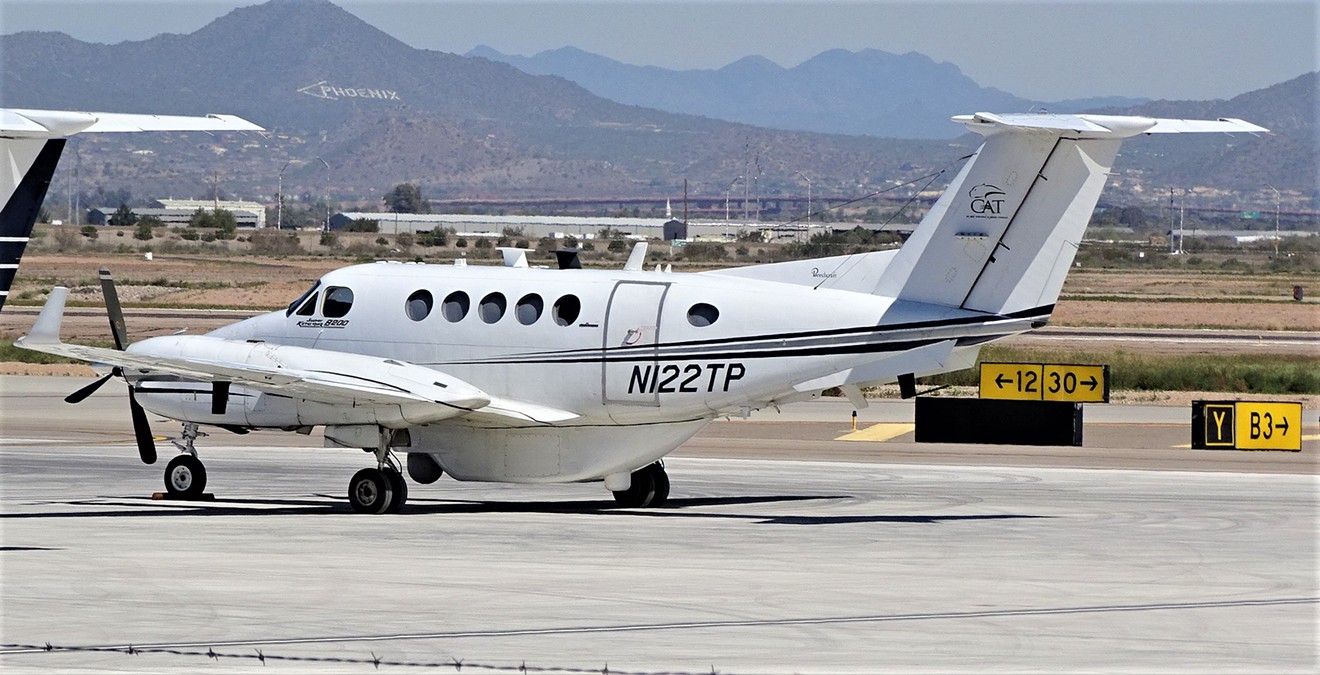The plane, however, was no rookie pilot testing her wings in a lazy spiral. It was assisting a pre-deployment training exercise for the U.S. Marine Corps, with support from the Phoenix Police Department's tactical unit.
Recently, BuzzFeed reported that the company which flew the plane over Phoenix is a frequent contractor with the U.S. military, which employs these planes in aerial surveillance missions in Africa. The plane was over Phoenix during the week of March 9-17 as a part of a training exercise for the U.S. Marine Corps. The Phoenix Police Department’s SWAT unit participated, too, acting as a foreign security force.
For the exercise, the Beech B200 Super King Air turbo-prop aircraft was retrofitted with surveillance technology. Documents obtained by BuzzFeed show the plane carried a technology known as Nebula, which can connect to and track a cellphone on the ground.
The question is: Why?
The answer lies at the tangled intersection of an multiagency tactical exercise and the nascent world of aerial surveillance technology.
A spokesperson for the Marines said the training was nothing out of the ordinary — in line with regular pre-deployment exercises for the Marine Corps.
Lieutenant Mallory Martinez, a public information officer with the I Marine Expeditionary Force, said the 15th Marine Expeditionary Unit was in Phoenix to conduct “realistic urban training” in preparation for their current deployment in the western Pacific region.

Historical flight data shows that on March 16, the surveillance plane circled around and around central Phoenix, as well as Tempe.
Screengrab/ADS-B Exchange
The 15th Marine Expeditionary Unit previewed the training in Phoenix by describing how the exercises will allow Marines to rehearse urban raids in an unfamiliar city. The exercises were planned and executed by several units within the Marine Corps, including the I Marine Expeditionary Force and the 15th Marine Expeditionary Unit, with support from the Marines' special operations command.
But it was not just Marines training together: The Phoenix Police Department’s SWAT team, known as the Special Assignments Unit, was also alongside the Marines during the exercises.
“The Phoenix SAU was participating as role-players for the scenario by simulating a foreign security force,” Martinez said.
A Phoenix police department spokesperson acknowledged that the department occasionally participates in a variety of training sessions with other agencies. Sergeant Jonathan Howard said Special Assignments Unit officers “conduct high-risk search warrants, barricade negotiations, search for high-violence potential suspects, conduct elevated rescue missions, and anything that requires a higher level of specialized team training to ensure a safe operation.”
In this case, Phoenix Police thought its Special Assignments Unit personnel could learn from U.S. military’s unit that specializes in rapid response.
“Although the missions are different, some of the tactics employed are similar,” Howard wrote in an email to New Times. “In order to ensure we are keeping current in the latest techniques, we observe and work with others to see if we can incorporate different techniques into our program.”
The technology on the aircraft raises questions about privacy. According to documents obtained by BuzzFeed, the technology on board is known as Nebula. By simulating a cellphone tower, Nebula causes phones on the ground to try to connect to it. The technology can then track an individual phone. Additionally, the aircraft had a powerful wide-area camera.
Arizona, it must be noted, has lagged behind other states in cellphone privacy laws; it was only this month that a law went into effect that requires a warrant for police to track cellphone location data.
The spokeswoman said the Marines understand concerns about privacy and surveillance. Martinez assured New Times that the cellphone technology on the aircraft was used only on “government-owned or government-contracted equipment” during the exercise. And she emphasized that the military oversees such activities with rigor.
“Should citizens be concerned that the military is surveilling them? The answer is absolutely, ‘No,’” Martinez said. “Each exercise has an intelligence oversight officer who supervises the proper handling of all exercise materials. And the inspector general verifies compliance with all appropriate procedures. So, there are a lot of checks with this training.”
According to BuzzFeed, the contractor that owns the plane that flew over Phoenix has also been a contractor for flights over various cities during other military exercises, including activities at the Marines base of Camp Pendleton in California and several Gulf Coast cities in Alabama, Louisiana, and Mississippi.
The agreement with the city of Phoenix was signed by Phoenix Fire Department Chief Kara Kalkbrenner and an assistant chief of staff with the Marine Corps. It says the Marines will make use of the fire department's special operations facility and training academy grounds.
A small subsection notes that the Marines "may collect overhead imagery and remote-sensed data at the Special Operations Facility and training grounds," but the document adds that the information will not be used in any law-enforcement investigations.
However, there was no public input on the training exercise. According to the fire department, a city attorney reviewed the agreement. But the city council did not vote on the matter and the paperwork was between the Fire Department and the U.S. military.
For its part, the Phoenix Fire Department said it welcomes any chance to collaborate and train with outside partners.
"We basically welcome all emergency-response agencies into our realm because it acts as a force multiplier when something bad happens," said Shelly Jamison, deputy chief of the fire department. Jamison said that because Phoenix is home to millions and plays host to massive events like the Super Bowl, the city necessarily has to work with other agencies in the event of a potential terror attack.
And it seems that a terror attack would invite surveillance and a tactical response of the kind that was deployed in Phoenix. The airplane company employed by the military in Africa has used surveillance technology to locate terrorist cells such as Boko Haram and al-Shabaab.
Major Nicholas Mannweiler, a spokesperson for the U.S. Marines Special Operations Command told New Times in an email that shared roles in a crisis meant local law enforcement could participate in the training exercise, too.
"As part of the training support for the scenario, there was a need to accommodate special operations actions that would take place in a real-life operation," he wrote.
Jamison of the fire department said these training exercises are part of disaster prep. She added that in the run-up to a Super Bowl or large event, Phoenix prepares for anything, reviewing so many possibilities that it might alarm the average resident.
"I’m sort of glad you don’t know about it," Jamison said.
And although the prospect of overhead surveillance is alarming, the Marines argue that the surveillance plane was a "small footprint" of the training in Phoenix. Martinez said that it wouldn't make sense to violate privacy of the people on the ground for what was merely a training.
"The training in a realistic environment, that takes place all the time," she said. "So why would we do anything unethical or anything illegal in this nothing-out-of-the ordinary, routine realistic urban training?"












